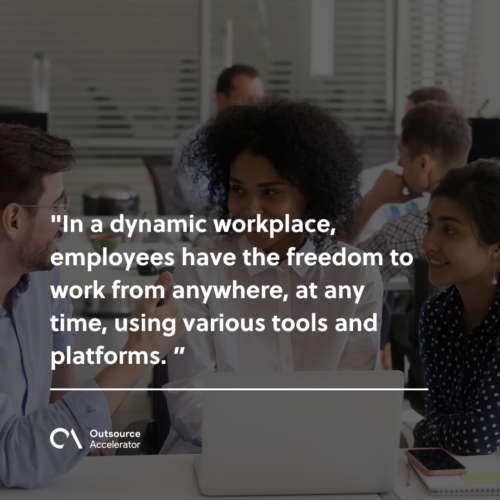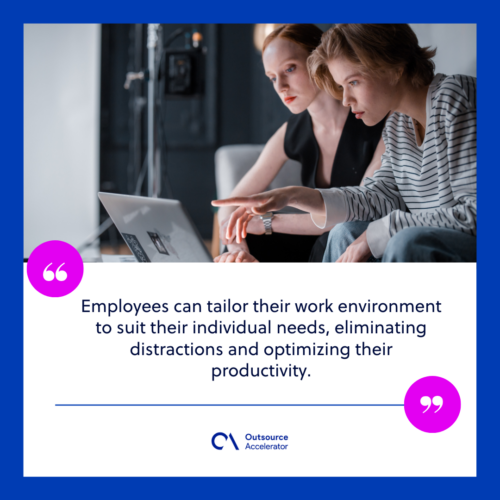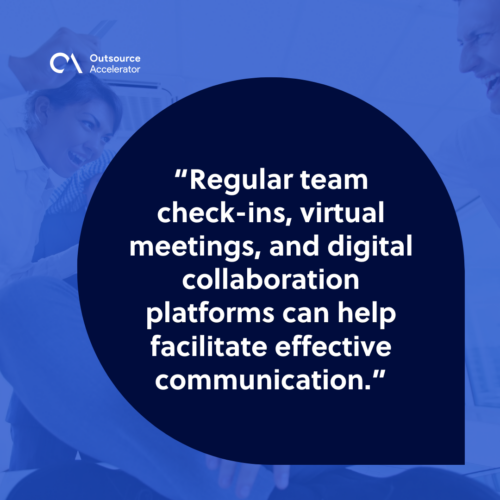How a dynamic workplace benefits your business

The workplace has been rapidly changing.
With the rise of remote and hybrid setups, people may wonder whether the office is still relevant. Luckily, corporate real estate keeps up with ways to adapt to this change in the form of a dynamic workplace.
Get to know the dynamic workplace setup and how it benefits your business through this article.
What is a dynamic workplace?
A dynamic workplace is a reconfigurable work environment that adapts to a staff’s needs. It allows them to work on their terms as long as they produce their expected output.
In a dynamic workplace, employees have the freedom to work from anywhere, at any time, using various tools and platforms. They are not bound by rigid schedules or physical office spaces, allowing them to be more productive and innovative.

Benefits of a dynamic workplace
A dynamic workplace is beneficial in terms of flexibility and mobility within your teams.
Here are some of these advantages:
Increased employee engagement
One of the significant benefits of a dynamic workplace is increased employee engagement.
Employees can choose where and when they work and feel empowered and trusted. This autonomy leads to higher motivation and commitment to their work, resulting in greater productivity and job satisfaction.
Enhanced collaboration and innovation
In a dynamic workplace, the barriers to collaboration are eliminated. Employees, regardless of their geographical location, can easily connect and collaborate on projects using various communication and collaboration tools.
This virtual teamwork encourages diverse perspectives and fresh ideas, leading to innovation and improved problem-solving.
Companies like Google have leveraged dynamic workplaces to create interdisciplinary teams that drive innovation.
Improved work-life balance
A dynamic workplace promotes work-life balance by allowing employees to balance out their personal and professional responsibilities.
Employees can better juggle their commitments without sacrificing job performance by working remotely or adjusting their work hours.
Employees with a better work-life balance are more satisfied with their jobs. This leads to increased retention rates and reduced absenteeism, ultimately saving businesses significant costs associated with turnover and employee disengagement.
Attracting and retaining top talent
A dynamic workplace is a powerful tool for recruiting and keeping high-performing employees. This setup allows employers to attract and retain talents from various backgrounds and demographics.
Millennials, for instance, value flexibility and work-life balance, making a dynamic workplace attractive for this generation.
Increased productivity and efficiency
Having a dynamic workplace can significantly boost productivity and efficiency. Employees can tailor their work environment to suit their individual needs, eliminating distractions and optimizing their productivity.

Challenges of a dynamic workplace
While the benefits of a dynamic workplace are undeniable, there are challenges that organizations may face when implementing such a work environment.
Limited collaboration
A dynamic workplace tends to limit collaboration when brainstorming ideas.
Maintaining seamless communication can be challenging with employees in various locations and working at different times. Meanwhile, most teams best maximize brainstorming in person, where they can share their insights better.
Organizations must invest in robust communication tools and establish clear communication protocols to bridge the gap and facilitate collaboration.
Security and privacy concerns
With employees working remotely and accessing sensitive company information, organizations must prioritize cybersecurity and data privacy.
Dynamic workplaces are vulnerable to data breaches and other security issues with employees using personal devices such as laptops.
Implementing stringent security measures is crucial to protecting sensitive data and ensuring compliance with regulations.
Managing remote teams
Managing remote teams requires different skills and tools than traditional office management.
Leaders must establish clear expectations, provide regular feedback and support, and foster a sense of belonging within remote teams.
Implementing project management and collaboration tools can help streamline communication and ensure productivity.
Technological infrastructure
A dynamic workplace heavily relies on technology to enable remote work and collaboration.
Organizations must invest in robust technological infrastructure to support employees’ needs and provide seamless access to necessary tools and applications.
Regular IT support and training are also essential to ensure employees can effectively utilize the technology available to them.
Maintaining company culture
Creating and maintaining a strong company culture can be more challenging in a dynamic workplace due to the physical distance between employees.
Organizations must find creative ways to foster a sense of belonging and connection, such as virtual team-building activities and regular virtual meetings.
Additionally, leaders should lead by example and set the tone for a positive and inclusive workplace culture.
How to create a dynamic workplace
Creating a dynamic workplace requires a strategic approach considering the organization’s unique needs and goals.
Here are some key steps to consider when transitioning to a dynamic workplace:
- Establish employee guidelines and expectations regarding performance, communication, and collaboration. Communicate the benefits and objectives of the dynamic workplace initiative to gain employee buy-in and understanding.
- Provide employees with the necessary tools and technology to collaborate remotely. This may include cloud-based applications, project management tools, video conferencing software, and secure connectivity options.
- Define clear communication protocols and channels to ensure seamless communication and collaboration. Regular team check-ins, virtual meetings, and digital collaboration platforms can help facilitate effective communication.
- Offer comprehensive training and support to employees on effectively navigating the dynamic workplace environment. This includes training on remote work best practices, cybersecurity awareness, and utilizing technology tools.
- Build a culture that values trust, autonomy, and accountability. This can be achieved by providing regular feedback and creating opportunities for employees to take ownership of their work.

Increasing efficiency with a dynamic workplace
A dynamic workplace can significantly increase efficiency by enabling employees to work in environments that optimize productivity.
Here are some ways a dynamic workplace can increase efficiency:
Reducing commute time. With remote work, employees can save valuable time by avoiding daily commutes.
Tailoring work environment. A dynamic workplace allows employees to choose work environments that suit their needs. Some may prefer quiet spaces, while others thrive in bustling coffee shops.
Maximizing productive hours. The flexibility of a dynamic workplace enables employees to work during their most productive hours. For example, early birds can start their workday earlier, while night owls can work during peak hours.
Adaptability to change. Lastly, a dynamic workplace cultivates a mindset of flexibility and adaptability, allowing businesses to respond quickly to changes and challenges.







 Independent
Independent




